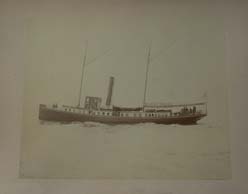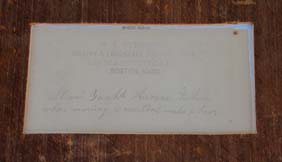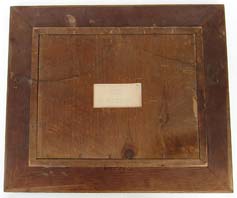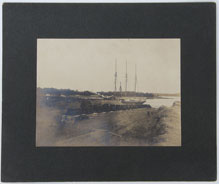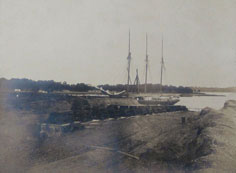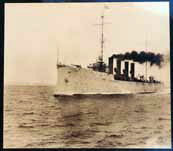VINTAGE PHOTOGRAPHY
Catalog Page 15
When no price is shown, use
Click on photos for larger images.
Click
![]() for ordering details.
for ordering details.
|
15.93 PERIOD PHOTO. Original
photograph of the wreck of the steamship SS ANNA
SCHAFER on the rocks on the approaches to the Golden
Gate of San Francisco Bay. The ill-fated 4-masted
vessel can be clearly seen with her name just visible on the
starboard bow. The clear black and white image
measures 8 by 9 ½ inches and is in its nice, period
wood frame under the original old glass measuring 9 ¼
by 11 ¼ inches overall. Ready to hang.
29 |
|
DETAIL
|
BACK
|
|
15.92 FAMOUS PHOTOGRAPH. Original late 19th century, large format albumen photograph signed and identified by the noted Boston marine photographer Nathaniel L. Stebbins. This handsome example is “blind signed” (impressed) lower right “N.L. STEBBINS Photo BOSTON.” Then it is stamped in ink on the reverse, “N. L. STEBBINS. MARINE & LANDSCAPE PHOTOGRAPHER, 521 WASHINGTON ST. BOSTON, MASS.” Further it is pencil signed in the photographer’s own cursive hand, “Steam Yacht Aurora taken when moving 10 nautical miles per hour.” This photo depicts the large 2-masted steam/sail yacht on the port beam. The detail of this photograph bears close scrutiny under magnification showing 2 crewmen on the foc’scle, the vessel’s nameboard reading “AURORA” on the pilothouse, looming smokestack and at least 6 of the owner’s party on the fantail. The image measures 9 3/8 by 7 ¾ inches sight and is matted on its original tan mat under the original old wavy glass measuring 13 ½ by 10 ½ inches. It is housed in the original solid oak frame with fancy gilt liner measuring 20 by 17 inches overall. The back retains its original single pine board backing held in with hand-cut square nails. The overall presentation is in excellent original condition throughout. 395 Nathaniel Livermore Stebbins (1847 - 1922) is quite
arguably the most famous American marine photographer in
history. His photographs documented an important era
in the development of American maritime activities at a time
when the industrial revolution was taking hold. The
revolution created sweeping technological and social changes
in the activities of military, commercial and leisurely
ocean travel. The steam auxiliary 2-masted schooner yacht AURORA was recorded in the 1895 edition of the “Annual Report of the Supervising Inspector General” dated September 9 – “Steam Yacht Aurora coming out of Salem Harbor, collided with a dory containing six persons, but no one was hurt.” |
|
DETAIL
|
LABEL
|
BACK
|
|
|
|
|
|
|
|
|
 |
|
15.89 SCHOONER PHOTO. Original 19th century albumen photograph of a 3-masted schooner at anchor. The reverse is signed in pencil “Sch at Boston.” The image measures 4 ½ by 6 ½ inches and is mounted on its original heavy photo card mount 6 ½ by 8 ½ inches. Untouched original condition. 5 |
 |
|
15.91 SIGNED PHOTO OF NAPLES HARBOR. Genuine latter half of the 19th century albumen photograph depicting a panoramic view of the city of Naples, Italy and its busy harbor with Mount Vesuvius looming in the distance. It is titled “Napoli dalla Certosa S. Martino” (Panoramic view from the Charterhouse of San Martino) lower center and is signed “(Edizione Esposito)” lower right. This incredibly detailed photograph bears scrutiny under magnification. Clear to be seen are details of the city with its many buildings and streets. Even people and carriages can be seen in the main square just right of center and nearby the commercial wharfs. The busy harbor accommodates many ships, several of which are sailing vessels. Inside the jetty on the right are at least 4 large military vessels. Then of course majestic Vesuvius lords over the entire scene. This bright image measures 8 by 10 inches sight and is mounted on its original heavy photo card 10 ¾ by 14 inches. Outstanding original condition. Circa 1885. 95 A Rhode Island photographic dealer has a similar photograph by E. Esposito in poor condition, offered for $250. The Charterhouse of San Martino is a large monastery complex known as the Certosa di San Martino (St. Martin's Charterhouse) on the hill of Sant’Elmo on the Vomero overlooking Naples. Construction of the monastery began under Charles of Anjou (Duke of Calabria) and was finished in 1368. In 1866 it was converted into the National Museum of San Martino. |
|
15.88 SCARCE MID-WEST NAUTICAL
PHOTO. Authentic 19th century albumen
photograph of the 3-masted schooner C. C. MILLER in
drydock. The upper left back of the photographed is
penned in old ink “C.C. Miller,” then in pencil “Des
Moines.” The clear original image was printed
from a glass plate then mounted on its original heavy photo
card mount measuring 10 by 12 inches. The image
is 6 by 8 inches sight. Untouched original condition.
19 |
|
15.87 PERIOD SHIPBUILDER’s PHOTO. Genuine, very early 1900’s silverplate image of the brand spanking new steam/sail fishing schooner “SURF” as seen on the quarterboard. This detailed sepia tone image depicts the vessel from a port bow aspect along the wharf. The handsome 2-masted schooner has a turtle focs’le and a small pilot house with a very prominent smokestack just abaft the small pilot house. It is docked in the frigid waters of the Massachusetts winter, frozen in thin ice. The lower right of this photograph is blind signed (impressed) “PHOTO BY / GEORGE W. LORD / FORE RIVER SHIP B’LD’G. CO.” It is mounted to its original stiff card which measures 11 by 14 inches. The image itself measures 7 ½ by 9 ½ inches. Absolutely perfect condition, being as bright as the day it was taken! 95 The steam/sail 2-masted schooner SURF, call sign LCGR, was launched by the Fore River Shipbuilding Yard, Quincy, Massachusetts in early 1911. She had a length of 118 feet, a breadth of 22 ½ feet and a draft of 12 feet. She was owned and operated by the Bay State Fish Company, Boston, which to this day has a prominent presence on Boston’s downtown waterfront. |
|
15.84 USS OLYMPIA PHOTOGRAPH. Impressive panoramic photograph of the festive welcoming of Admiral Dewey’s flagship the USS OLYMPIA upon returning from its around the world cruise and celebration of it victory over the Spanish Armada in the Spanish-American War. This original silver plate photograph is blind signed lower right “Copyright 1902 C. E. BOLLES, BROOKLYN, N.Y.” It depicts the white battleship surround by numerous tugboats festooned with flags and pennants. Several bear bold banners reading “POLICE.” In the background can bee seen the harbor surrounds, which look more like Boston than Brooklyn. The perfect image is clear and bright, measuring 7 by 9 ¼ inches sight under a gray mat measuring 13 by 15 inches. An original historic photograph over 100 years old. 295 |
|
IMAGE
|
|
15.83 FAMOUS PHOTOGRAPH.
Genuine very early 1900’s glass plate silver print of
the Cruiser USS CHESTER (CL-1) on a speed run, as taken by
renowned marine photographer N.L. Stebbins. This
spectacular photo is signed lower left, “18486 U.S.S.
Chester Copyright 1908. by N. L. Stebbins. Boston, Run 10.
South – 25.07 knots.” The port bow shot
shows the vessel under a full head of steam belching black
coal smoke. This detailed image bears close scrutiny
under magnification revealing the Union Shield adorning the
prow, 5 inch deck gun, officers manning the flying bridge
and many other deck details, including crewmen aft.
The coast of Massachusetts can be seen in the
distance. 8 ½ by 7 ½ inches sight, mounted
on its original hard dark gray card 14 by 11 inches.
Shrink-wrapped on foam core backing.
Mint condition.
269 GENERAL CHARACTERISTICS |
 |
|
15.79 EARLY NAVY PHOTO. Very unusual late 19th century albumen photograph of officers posed on the deck of a U.S. Navy warship. What is so very rare about this group photo is that women in their Victorian finery are mingled amongst the smartly uniformed officers! There are a total of 19 officers and 4 women plus a crewman behind and 2 standing on the upper deck in the background, for a total of 26 individuals. A large Dahlgren gun is shown in the left foreground. On the deck above stands a sailor in flat hat holding a large telescope. To his left is an early wooden hexagonal binnacle on pedestal with another sailor standing behind. Faintly visible is standing rigging and a mast indicating this is aboard a sailing ship. And the fact that the binnacle is non-compensating means it is a wooden sailing ship! The image itself measures 7 ½ by 9 ½ inches sight. It is mounted on its original heavy card backing which is signed “CREWES, PHOTOGRAPHER CAPE TOWN”. There is a faint penned inscription in the lower center which we have not been able to decipher. Perhaps a better eye could ascertain the identity of the ship! The mat opening is 9 ¼ by 10 ¾ inches mounted in a period frame under glass measuring 14 by 16 ½ inches. Condition is acceptable. The image is very clear but lightly soiled. There is a small tear with puncture upper middle which does not affect the main field of view. Circa 1880. 195 |
 |
 |
 |
|
|
|
|
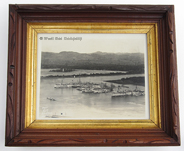 |
|
15.78 EARLY SUBMARINES PHOTO. Important, historic bird’s eye view photograph of the United State Navy's fledgling submarine base at the Panama Canal just after the First World War. This documentary sepia tone photograph on heavy card photographic paper depicts four large submarine tenders with submarines nested alongside. At least 13 submarines are seen in their berths with yet another clearly visible underway lower left. It is a high resolution image which bears close scrutiny under magnification, revealing details of the ships, the subs, a lighthouse in the distance and the masts and funnel of a ship at dock in the foreground. It is signed "PHOTO © BY A. E. WELLS" lower left. This original print measures 7 by 9 inches sight and 8 by 10 inches overall, housed in its original gilt walnut frame measuring 12 by 14 inches. Outstanding original condition. Clear and bright. A rare, historically important image documenting America's submarine service during its infancy! 295 This exact photograph is shown at: http://www.tendertale.com/ttd/ttd4/ttd4.html the U.S. Navy’s unofficial website for submarine tenders. It is entitled, “Photo # NH 42573 Submarines and submarine tenders at Cristobal Canal Zone, circa 1923.” The tenders are (left to right): SAVANNAH (AS-8), BUSHNELL (AS-2), BEAVER (AS-5) and CAMDEN (AS-6). Submarines are mostly "R" type boats, among them R-23 (SS-100) and R-25 (SS-102), both in the nest alongside SAVANNAH's port quarter. The bigger submarine alongside SAVANNAH's bow may be S-1 (SS-105), with her large seaplane hangar. As shown the vessels are moored in Manzanillo Bay just off of Coco Solo Point to the right. The lighthouse is on Margarita Island and the pier in the foreground is Manzanillo Point. When the Panama Canal opened in January of 1914 the United States was very concerned about protecting its strategic investment. At that time submarines were still considered as a coastal defense force and not useful for much else. So like Naval forces on Asiatic Station "showing the flag," five C Boats (OCTOPUS, STINGRAY, TARPON, BONITA, and SNAPPER) were deployed to Coco Solo with their tenders. A. E. Wells was THE official photographer for the U.S. Navy, War Department in the early 1920's. His photographs are contained in the archives of the Naval History and Heritage Command, Washington D.C. as well as numerous American museums nation wide. |
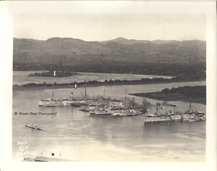 |
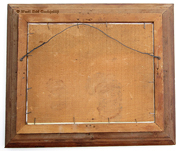 |
|
|
BACK |
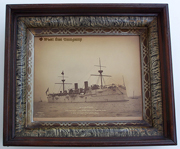 |
|
15.77 FAMOUS PHOTO. Original ship’s photograph of the USS BALTIMORE (Cruiser No. 3) taken by professional marine photographer Enrique Hart in New York Harbor as the vessel proceeded to the Presidential Review at Oyster Bay, New York 15-17 August 1903, with Theodore Roosevelt, 26th President of the United States, embarked. The hand-penned inscription at the bottom of the photograph reads, “U.S.S. Baltimore. With President of the United States and Party, en route to G.A.R. Encampment at Boston, Mass.” Signed lower right “E. H. Hart. 248 - E. 23D St., N.Y.” This sepia tone photograph shows a starboard bow view of the imposing iron man-o-war with ram bow, two masts and two funnels, flying the American ensign from the stern. Several crewmen can be seen on the focs’le and open bridge. Sailing craft dot the background and the New York waterfront is in view. This fine image under old wavy glass measures 8 by 9 ½ inches sight and is housed in its ornate Eastlake walnut frame measuring 12 by 14 inches. Outstanding original condition in all respects. 795 USS BALTIMORE was launched October 6, 1888 by
the William Cramp & Sons Ship & Engine Building
Company, Philadelphia, Pennsylvania and commissioned January
7, 1890. From the Dictionary of American Naval Fighting Ships, this excerpt: “From 5 August to 23 December 1903 USS BALTIMORE (Cruiser No. 3) served with the Caribbean Squadron, North Atlantic Fleet, taking part in summer maneuvers off the coast of Maine, in the Presidential Review at Oyster Bay, New York (15-17 August), and in Santo Domingo waters. From 28 May to 26 August 1904, she was attached to the European Squadron and cruised in the Mediterranean. On 26 September she sailed from Genoa, Italy, for the Asiatic Station and spent the next two years cruising in Asiatic, Philippine, and Australian waters.” During the journey documented in this photograph, President Teddy Roosevelt delivered a speech to the Holy Name Society in Oyster Bay, New York on August 16,1903. He is quoted: "It is no use to preach to [children] if you do not act decently yourself." After returning from the journey, in a letter to the citizens of Oyster Bay dated September 1st, the President wrote: "There are good men and bad men of all nationalities, creeds and colors; and if this world of ours is ever to become what we hope some day it may become, it must be by the general recognition that the man's heart and soul, the man's worth and actions, determine his standing." |
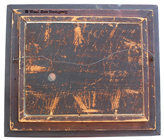 |
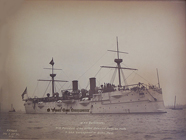 |
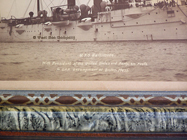 |
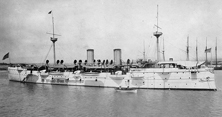 |
|
|
|
INSCRIPTION |
SHIP |
|
|
|
15.50 MUSEUM PHOTOGRAPH SET. Complete set of 5 exhibition photographs taken by professional marine photographer Kenneth Jenkins of Oakland, California. These museum quality photographs each bear exhibition markings on the reverse indicating that they we shown at the Mariner's Museum in Newport News, Virginia in 1953. The prints are numbered consecutively 1 through 5 and are meticulously titled, described, and documented in the photographer's own words on the reverse. They read: "1. SCHOONER BOWS, Not exactly a common sight today, two large 3-masted, deep-water schooners berthed side by side. The schooners being the CHARLES R. WINSLOW and her near-sister C. A. THAYER; 2. BLACK DOUGLAS, The converted schooner BLACK DOUGLAS taken from a Mexican "Bum Boat"; 3. LIMEJUICE TRAMP, A typical British Tramp Steamer, the S/S KINGSMOUNT; 4. SEAMYSTERY, The Liberty Ship SEAMYSTERY; and 5. MEXICAN LEE, The converted schooner BLACK DOUGLAS, photo taken on Isla Santa Margarita." Each of these original black and white photographs measures 7 by 9 1/2 inches sight and is mounted onto its original card measuring 16 by 20 inches. All are in an outstanding state of original preservation. A rare full set of museum photographs well over a half century old! 95 for all five! |
|
|
|
|
|
|
|
|
|
FULL MAT |
|
|
|
|
|
|
|
|
|
|
|
|
|
|
|
|
|
|
|
15.61 EARLY LAUNCHING PHOTOGRAPH. Important and rare, signed, dated and identified early albumen photograph of the launching of the 4-masted schooner FREDERICK BILLINGS at Rockport, Maine, 1885. This fabulous photograph depicts the exact moment when the large schooner plunges into the water, much to the delight and amazement of onlookers poised in small boats in the foreground. The photograph shows remarkable detail and bears close scrutiny under magnification to see the surrounding town, the intricacies of the ship itself, and the numerous onlookers -- on shore and on the decks. The back of the image is boldly signed by the photographer, "Ship Frederick Billings, Built by Carleton, Norwood & Co., Rockport, Maine, 1885, Master Builders, John Pascal & Son. - Dimensions of Ship: . . . - Photographed by W.V. LANE, Camden, ME." It goes on to advertise the photographer's prowess and states, "These views give a perfect picture of the ship as she descended into the water. The friction of the ways was so intense as to cause smoke, like fire, and it is photographed perfectly in the picture." The image measures 7 3/4 by 9 1/2 inches sight and is professionally matted under old glass in its original gilt-lined walnut frame measuring 13 1/2 by 15 1/2 inches. A really exceptional photograph which captures a remarkable moment in time over 135 years ago! 495 |
|
|
|
|
|
|
|
15.51 CIVIL WAR SAILOR. Very fine cased tin type image of an American sailor during the Civil War. This eighth plate tin type depicts a very handsome young man posed in a studio setting in the typical "flat hat" of the era with a bos'n pipe lanyard prominent on his uniform. Encircling the oval image is a bright gilt patriotic metal border depicting eagles carrying American flags, cross rifles and swords, cannons and drums, all within an ornate foliate border. This in turn is encased under glass in a wooden leather covered case with hinged lid lined with velvet in a decorative floral pattern. The exterior of the leather case is embossed with floral designs and retains its original hook and eye closure, all in outstanding condition. 2 1/2 by 3 inches. Very rare American Naval subject matter from the Civil War. 495 |
|
|
|
|
|
|
|
15.48 PERIOD PHOTOGRAPH. Original, 19th century albumen photograph of an American passenger vessel steaming down a river with flags flying and numerous passengers visible on deck. This 4 x 5 inch photograph contains an incredible amount of detailed imagery and bears close scrutiny under magnification. The central vessel is identified on the bow as the "D.B.C. & A. LINE's" R.G. STEWART underway with smoke belching from her single funnel. As she proceeds, she passes a variety of shipping, including a tugboat and schooner berthed on her starboard side and a lighter and large steam ship to port. Buildings line both sides of the river and a revolving bridge with several spectators spans the river in the distance. On deck scores of passengers in their Victorian finery can be seen. The men sport bolder or top hats, and the women, some with umbrellas, wear bonnets. Two large name pennants fly in the breeze, and the American flag is distinctly visible at the stern. The reverse of the photograph is signed by the photographer "William Howard." This untouched photograph is mounted under glass in a very high quality dark oak frame with an ivory border! The frame measures 7 1/2 by 6 1/2 inches and has a small brass suspension loop for hanging at the top. Outstanding original condition. Circa 1885. 395 According to the "List of Merchant Vessels of the United States - 1895" the steam screw, wooden hull passenger ship R.G. STEWART was built in Buffalo, New York in 1878. She was a Great Lakes vessel of 198 gross tons and 100 feet in length, home ported in Duluth, Minnesota. The STEWART no longer appears in the 1899 register of Merchant Vessels, proving that this image is definitely 19th century. Likely this photograph was taken of the STEWART while plying the St. Louis River which flows into Lake Superior at Duluth. |
|
|
|
|
|
DETAIL |
|
|
|
15.41 PHOTOGRAPH. Late 19th century silver process photograph identified as the "Bark Levi G. Burgess J. Younger, Master" as hand written across the bottom. This period image shows the Burgess alongside the wharf. An old fashioned steam "donkey engine" can be seen to the left, and in the background the roof of one of the buildings reads "...RSON BUILDER." This image shows good detail under magnification and the vessel name can clearly be seen on the port bow. The image measures is in perfect condition and 7 by 9 inches sight. It is mounted on it original card (rough edges) with the additional notation on the back, "Built Thomaston (Maine) 1877." Perfect for framing. 149 This original photograph shows the LEVI G. BURGESS docked in San Francisco sometime between 1897-1900. Built as a full rigged ship by Samuel Watts at Thomaston, Maine, she was launched on Oct. 6th 1877. The LEVI G. BURGESS was named after the son of Captain Joseph S. Burgess of the famous shipping firm "Snow & Burgess" N.Y., who were part owners. She was a good carrier and made several fast passages "'round Cape Horn." Sold in San Francisco in 1887, she became a well known Pacific coast and "Offshore Trades" vessel. Re-rigged a Bark in 1897 (as shown in this photo) she did splendid service up until 1910 when she was sold to Alaska Portland Packers Association. Thereafter she operated as a salmon fisheries packer until 1928 when she was broken up and burnt for her metal. |
 |
 |
 |
 |
 |
 |
 |
 |
 |
 |
 |
 |
 |
 |
 |
 |
 |
 |
 |
 |
 |
 |
 |
 |
 |
 |
© 1998-2014 West Sea Co. All rights reserved.




